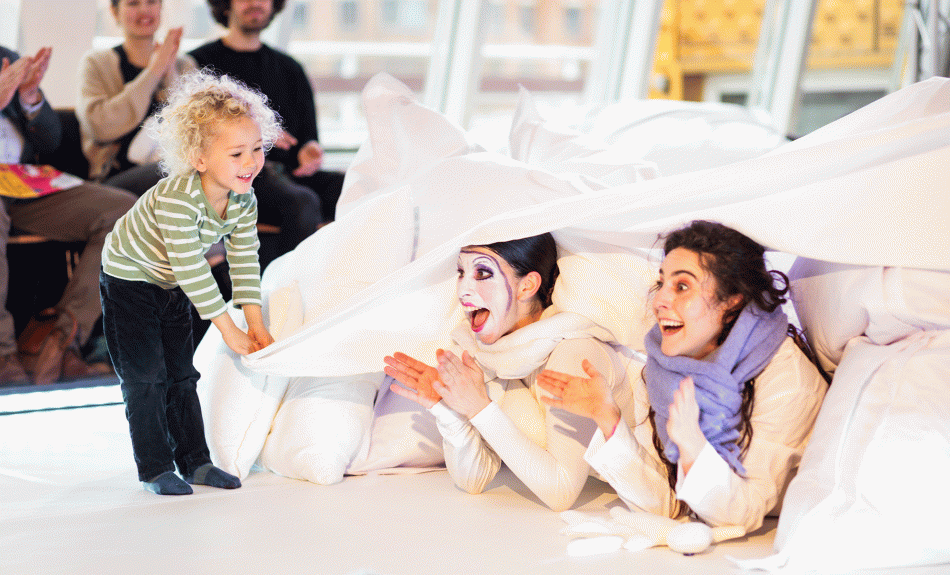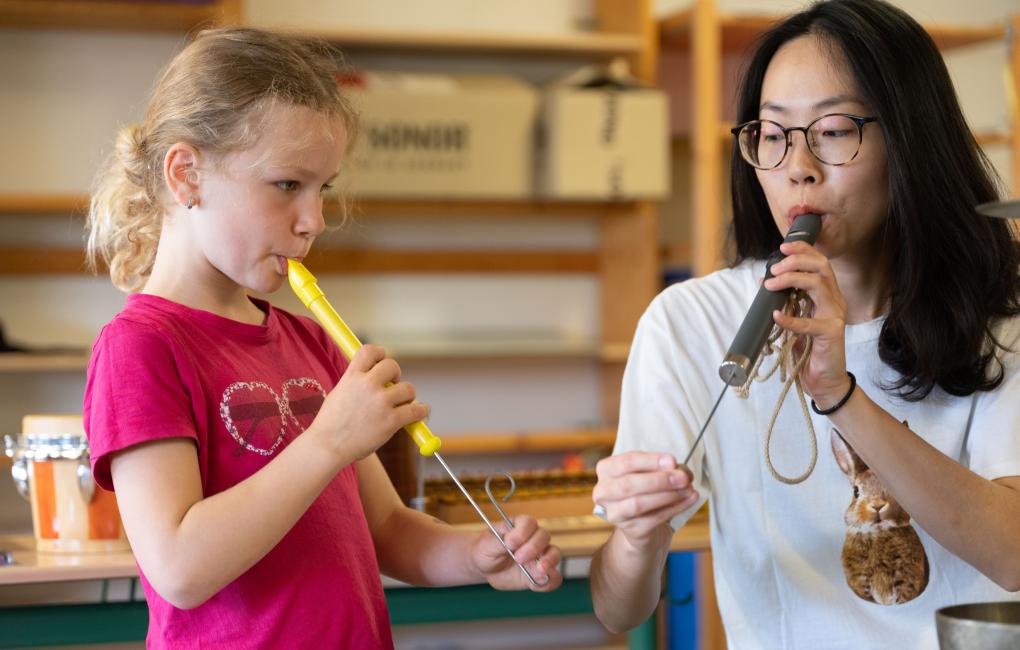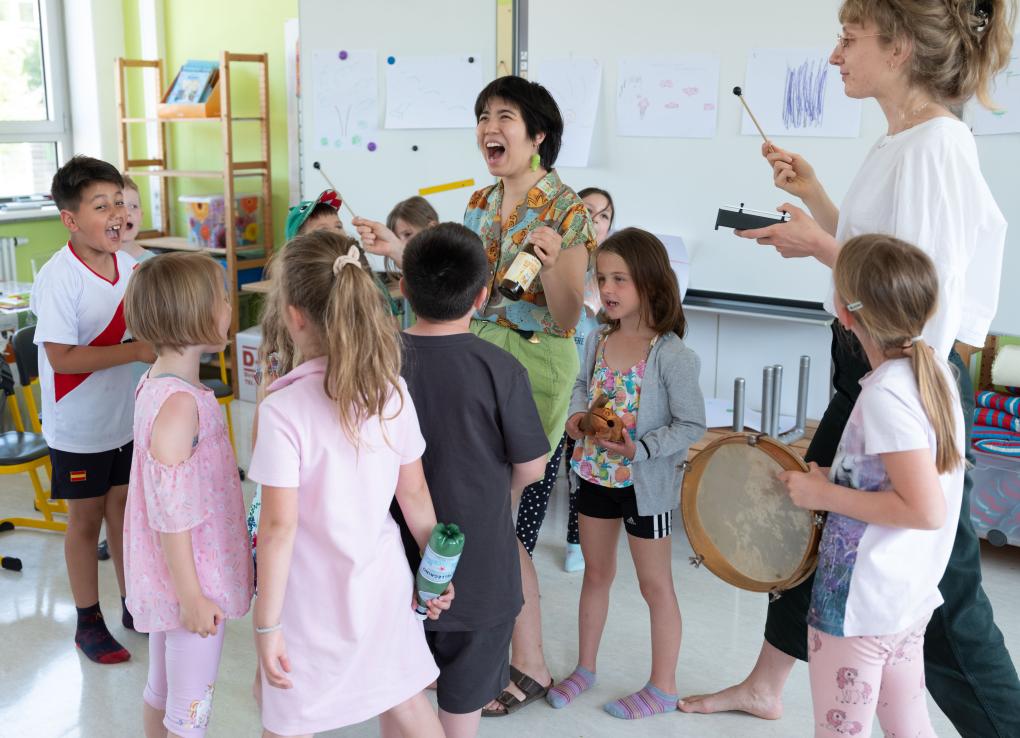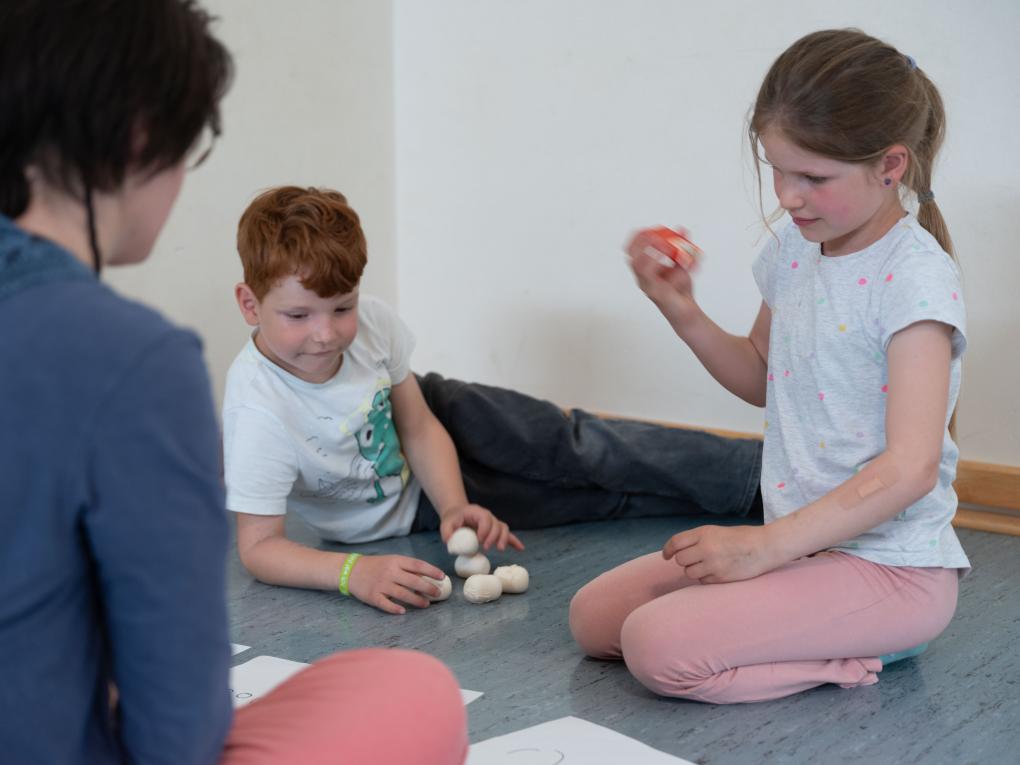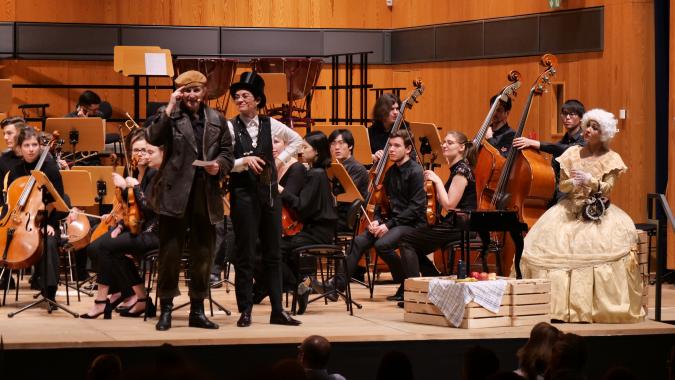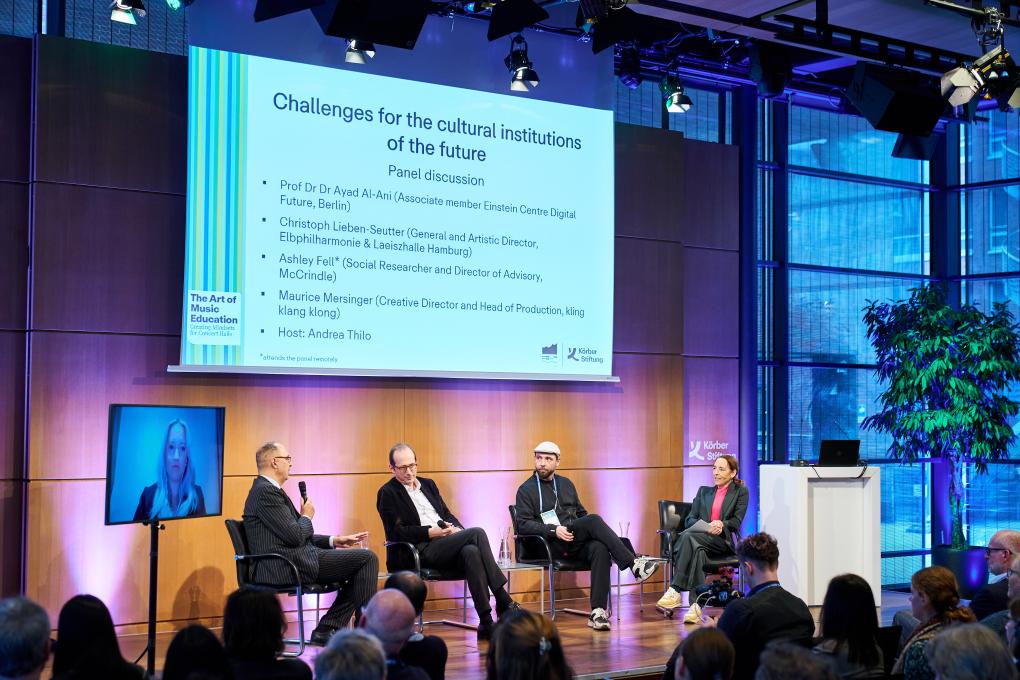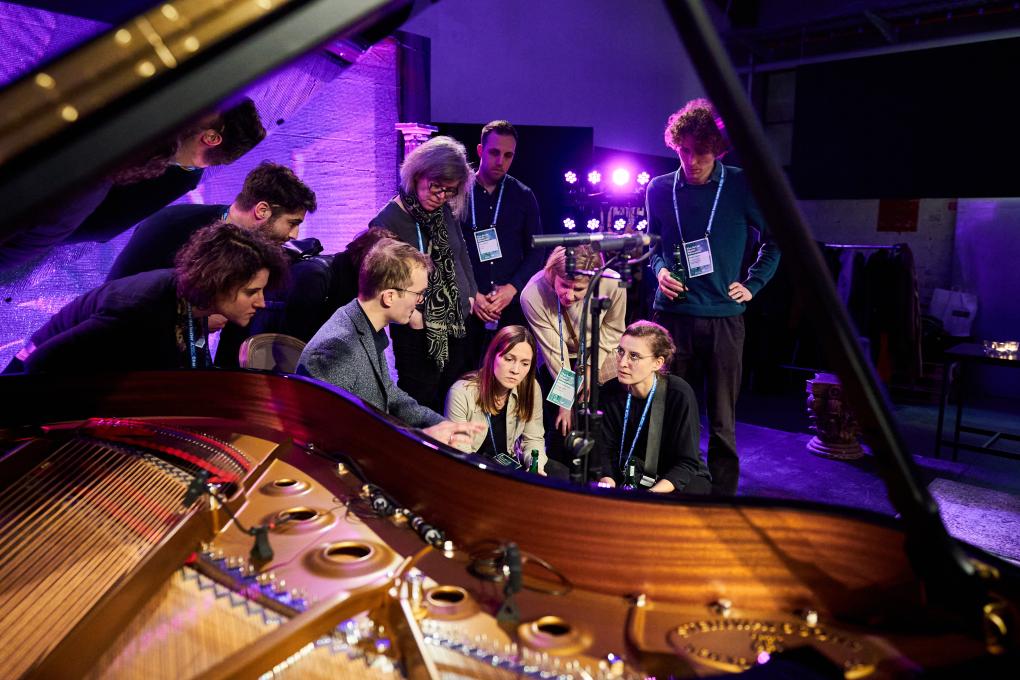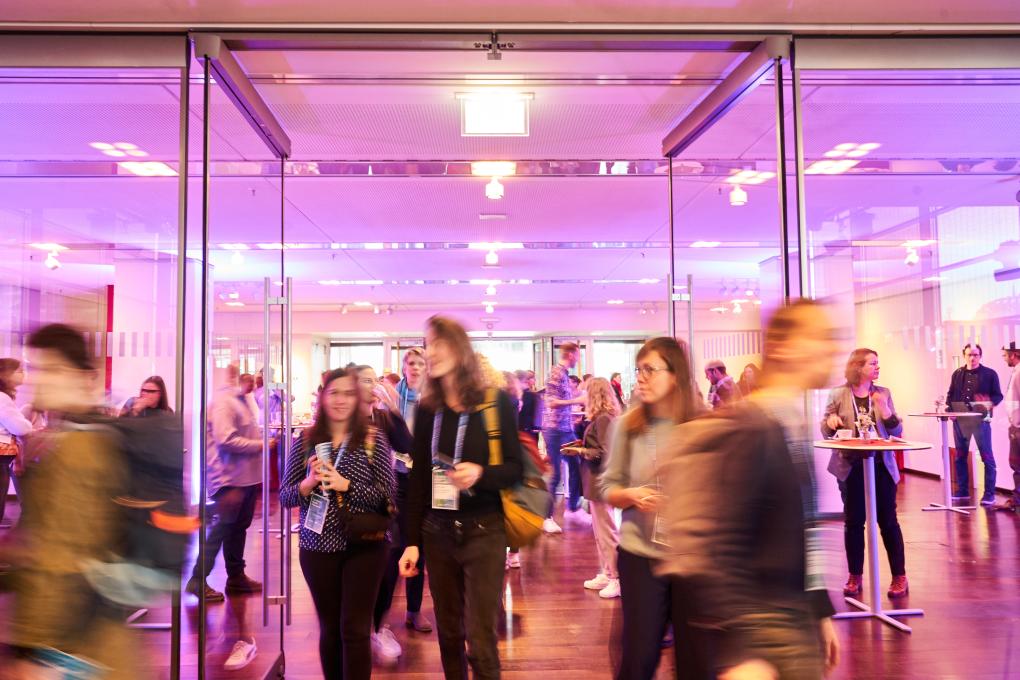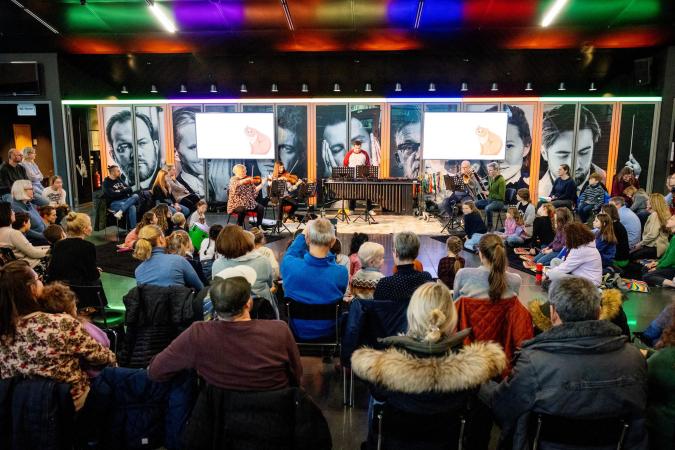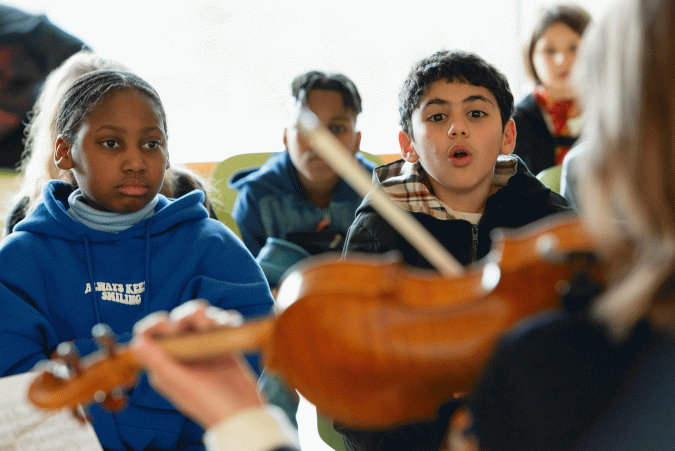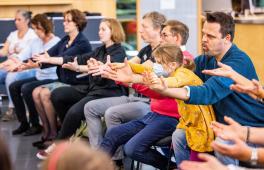Music mediation is a ‘wide-ranging artistic and educational practice that creates a variety of relationships between people and music.’ [1] It includes concerts for special target groups (e.g. children's concerts) as well as concert introductions, interactive workshop formats, outreach and community projects and media-based forms of medation (programme booklets, radio features, apps, etc.). The use of the term is anything but unambiguous, as is evident in the difficulty all publications have faced in trying to define it. Sometime it is used synonymously with what in German is called Konzertpädagogik, or ‘concert education’. This is hardly surprising, given the large market share of concert-related activities in this field. But music mediation activities need not be directly related to attendance at a concert. Moreover, the term is frequently used for activities outside the school system to distinguish them from music education at school, thereby making it synonymous with the now unfashionable term ‘extracurricular music education.’ [2] This overlooks the fact that ‘music mediation refers not only to various activities, but also to independent fields of action and specific ways of dealing with music’. [3] Indeed, to define the multi-layered field of music mediation as being ipso facto extracurricular is to fall far short of the mark. A glance at the many initiatives and formats that have emerged in this area in recent decades, and a glance at the importance of schoolchildren as a target group for music mediation, reveal that it makes little sense to insist on a sharp distinction between curricular and extracurricular. [4]
Perhaps the most meaningful distinction between music mediation and curricular music education lies in the emphases that the former places on the artistic and communicative element. Practitioners of music mediation are generally at pains to make a particular kind of music open to reception in its particular artistic context (e.g. a visit to a concert). In this case, the mediation process frequently involves professional artists, and central importance is attached to the artistic quality of the musical presentation. Like music teachers, music mediators employ educational resources in order to make it possible to learn about music and to experience it aesthetically. But rather than being restricted to musical facts and skills (i.e. the transmission of knowledge), music mediation is also concerned with connecting a style of music and the everyday world and experiences of the respective dialogue group. (i. e. the establishment of a connection). [5]
More on the topic
Handbuch Musikvermittlung
The handbook on music education provides an in-depth insight into the topic with essays from numerous experts from research and practice (only in German).
As the participants in music mediation (unlike school instruction) first have to be enlisted, another special communicative aspect is needed. Depending on whether music mediation is pursued with affirmative or transformative intent, different paths are possible. In terms of audience development, it can endeavour to open up new ‘target groups’ for its own institution, thereby confirming the content and values of its clients. [6] Or it can enter into a discourse at eye level with different communities as ‘dialogue groups’ [7] with the aim of changing ‘musical content and formats’ as well as ‘practices and structures of music ensembles or institutions with a view to shaping society.’ [8] However, this is a crucial task beyond the powers of a single individual, or even a single department: it must ultimately be tackled by an institution in its entirety. Music mediation can thus be understood as a cross-sector task with the potential to alter the structures and attitudes of cultural institutions in enduring ways. In this sense, communication is necessary not only toward the outside world but within the institution itself. The result is an extremely complex catalogue of requirements placed on the music mediator, who must slip into the role of ‘initiator or guide, role model or facilitator.’ [9] depending on the needs of the project concerned. Ideally, the music mediator must be an artistic, educational, communicative and administrative authority all rolled into one.
The beginnings of music mediation
The first attempts to engage young audiences by making a special selection of music for a classical concert date back to the 1830s, when the so-called ‘Juvenile Concerts’ took place in Boston. An increase in educational efforts at concerts became noticeable around the fin de siècle, perhaps in response to the growing influence of progressive education. [10] At this time Germany, too, witnessed the emergence of special concert series for children and young people. Among the concerts for schoolchildren and teachers were those mounted by the Hamburg Teachers’ Choral Society between 1898 and 1921, which were accompanied by special introductory talks by the artistic director, Richard Barth. Soon systematic thought was given to the criteria needed to make young people’s concerts successful. Here, for example, is the music educator and conductor Felix Oberborbeck, writing in 1928: ‘1) The concerts must meet all the prerequisites of youth psychology; 2) they must be given a systematic structure; and 3) they must satisfy the principles of artistic presentations in their time and location’. [11]
In the latter half of the 20th century an appreciation of the opportunities and the need for music mediation gradually took hold in Germany, too, mainly owing to Anglo-American influences. One milestone was the ‘Young People’s Concerts’ offered by the New York Philharmonic Orchestra, which were broadcast on television and thus available all over the world. Between 1958 and 1972 the composerconductor Leonard Bernstein devised no fewer than 53 such concerts for young people between eight and 18 years of age, functioning as conductor and moderator at once.[12] Bernstein was particularly effective in combining his artistic, educational and communicative skills in this concert format in order to open the gateway to classical music for children and adolescents. Even today many people still consider him the pioneer and prototype of the music mediator. Similar formats soon emerged in the German-speaking countries, including the ‘explanatory concerts’ (Erklärkonzerte) held for children by the conductor Gerd Albrecht, beginning in the 1970s.
Another impulse arose during the 1980s in England, where Gillian Moore, one of the world’s first music mediators employed on a full-time basis, held her first ‘Response Project’ with members of the London Sinfonietta. This format, in which children and young people compose and publicly perform their own music in the style of a reference work, proved extremely influential for the music mediation scene, especially in Germany. The first German ‘Response Project’ was given by members of the London Sinfonietta and Ensemble Modern at 17 Berlin schools in 1988. Thereafter the format was widely copied and has maintained a firm place in the music mediation portfolio of concert hosts to the present day. Moreover, the underlying idea of pursuing aspects of a concert programme by releasing the listeners’ own musical creativity, and thereby enhancing their receptivity to the concert itself, proved to have an influence on concert-related workshops as a whole. [13] In the 1990s many activities of this sort were carried out by musicians of the orchestras and concert halls concerned, who engaged in this field out of personal interest, often without payment.
Professionalisation and networking
Music mediation was placed on a more professional basis in the latter half of the 1990s when concert halls in the German-speaking countries first introduced paid positions for mediators. Initially these were usually lone warriors from non-musical departments, such as public relations or marketing. But in 2002 Simon Rattle and the Berlin Philharmonic set new standards by founding their education department ‘Zukunft@BPhil’. Then, in 2005, the documentary film 'Rhythm is it!' on the orchestra’s pioneering ballet project conquered the cinemas, making the potential of music mediation instantaneously clear to a broad public (even though some may have found its subtitle, ‘You Can Change Your Life in a Dance Class’, a bit over the top).
With the establishment of the new professional field of music mediation, the need arose for proper training facilities. The first degree programme in the German-speaking countries was launched at Detmold University of Music in 1998 as a job-attendant master’s degree. At the same time the first research activities began with Anke Eberwein’s study of concerts for children and young people (1998). Since then music mediation has been offered as a subject at a growing number of colleges and universities in Germany, Austria and Switzerland, whether as an undergraduate programme (Cologne University), a master’s programme (Trossingen University of Music) or in the form of elective modules and voluntary coursework. Moreover, a growing number of protagonists outside the university system offer advanced and post-graduate training in music mediation for professional and amateur musicians (e.g. Musikland Niedersachsen gGmbH). Finally, in 2010 the Körber Foundation in Hamburg launched an excellence initiative, the Masterclass on Music Education, with the goal of training future music mediation managers in close cooperation with leading concert halls throughout Europe. The scholarship programme was, however, discontinued after three cycles, probably for the simple reason that concert halls in the German-speaking countries have yet to institute such leading management positions.
The scene was further professionalised not least by the networking of its practitioners, in particular with the founding of the network ‘Junge Ohren’ (young ears) in 2007. This network has managed to start a lively exchange among music mediators through regional conferences, professional symposia and online resources. Since 2008 the Elbphilharmonie and the Körber Foundation have sponsored a biannual congress in Hamburg on ‘The Art of Music Education’ that has evolved into an important meeting place for the international music mediation scene.
Music mediation today
For 20 years concert-related music mediation has witnessed continuous growth. According to figures from the German Orchestra Union (Deutsche Orchestervereinigung, DOV), the annual number of such mediating events at the concerts of Germany’s publicly funded theatre, concert, chamber and broadcasting orchestras has more than doubled since 2003, while the number of symphony and choral concerts in the same period has remained virtually unchanged (see Fig. 4 in the essay ‘Professional Orchestras’ by Gerald Mertens). This steep growth curve bears witness to the increasing importance of music mediation for concert hosts and cultural facilities and has occasionally been interpreted as an ‘educational turn’ [14] in the arts. In addition to concert halls, choruses and orchestras, music mediation has also been discovered by broadcasting companies, opera houses, independent ensembles, festivals and museums. If smaller ensembles and festivals frequently retain freelancers to devise and conduct their music mediation programmes, most concert halls and orchestras now have at least one employee to develop, organise and carry out their activities. At present the Elbphilharmonie in Hamburg has the largest education department in the German-speaking countries, with 30 employees.
The wide-ranging music mediaton formats in existence today fall roughly into three categories:
- Concerts for special dialogue groups. Here music mediators develop concert formats designed to meet the needs of a particular target group, whether in their length, dramatic structure, choice of music, interior décor or the inclusion of narrative, theatrical, explanatory and/or interactive elements (e.g. baby and children’s concerts).
- Concert-related activities. Here music mediators develop educational formats to augment a concert for the benefit of specific dialogue groups, enabling listeners to enhance their musical experience. They may be explanatory (introductory talks) or participatory (workshops). In both cases musicians are often involved so that participants can establish personal ties to the artists. Equally widespread, in addition to activities inside the concert hall, are workshops, outreach projects and media-based forms of mediation (among others apps, programme booklets). Depending on the institution concerned, there may also be crossovers to neighbouring fields, such as theatre education at opera houses.
- Music mediation activities without a concert. Here music mediators who are not themselves active concert hosts develop educational activities unrelated to a concert visit. These might involve musical instrument museums, composer museums, art museums or musicological institutes that wish to use the methods of music mediation either to project their own musical content or to pave the way to other art forms and non-musical subjects. There are frequent crossovers to neighbouring fields of activity, such as art education and museum sciences. However, concert organisers sometimes also offer educational programmes with a more social objective comparable to community music, where attending a concert is not the focus (see, for example, the community projects of the Konzerthaus Dortmund).
While the earliest music mediation initiatives were generally directed toward children and young people, today’s cultural institutions have long set their sights on every age group, from new-borns to senior citizens. Some concert halls even make extremely narrow subdivisions in their dialogue groups. The Düsseldorf Tonhalle, for example, divides its children’s concerts into special offers for infants and one-year-olds, toddlers from two to three, preschool children from four to five, and even expectant mothers and their unborn children.
Besides a tendency to subdivide formats and dialogue groups, the last 20 years have also witnessed an expansion of the repertoire, as is best exemplified by the programmes of young people’s concerts. Until well into the 1990s children’s programmes in Germany were dominated by a small number of familiar, usually programmatic pieces such as Prokofiev’s Peter and the Wolf, Mussorgsky’s Pictures at an Exhibition and Vivaldi’s Four Seasons. [15] In contrast, today’s concert programmes offer a diverse repertoire encompassing not only classical music but folk, pop, jazz and contemporary music, sometimes specially composed for the given concert.
Goals of music mediation
The goals of music mediation are as varied as the mediators themselves and differ according to the institution involved and the specific possibilities and needs on location. However, what most activities do have in common might be the goal to enable musical experience. Music mediation can create occasions for ‘gathering experiences using cultural and artistic contents and forms while searching for locations, spaces and personal encounters between artists and audience that will make this interchange possible’. [16]
One recurring argument in the fundamental debate about music mediation is the view that it can defuse the crisis currently threatening classical music by attracting an ’audience of tomorrow’ (this is known as ‘audience development’). [17] Whether the fear of the alleged atrophying of the classical concert is actually warranted is quite another matter: In fact, a look at the statistics of the German Music Council shows that the decline in classical music audiences between the 2000-01 season and the 2014-15 season can be attributed exclusively to a decline in the music theatre sector (-17.7%), while attendance figures for classical concerts rose by 9.1% in the same period. [18] Whether the slump in concert attendance observed during the coronavirus pandemic is an expression of a long-term trend that was merely accelerated by lockdowns and concerns about infection, or whether the figures will return to pre-pandemic levels in the medium term, can only be speculated at present. Either way, the debate on the purported ‘crisis of the concert’ can be seen as ‘one cause of the need for music mediation and concert education, a need regarded today as self-evident’. [19]
Another goal frequently mentioned is to facilitate cultural participation. Many cultural institutions are concerned not only to address the highly educated, who have a strong affinity to culture in any case, but also, and equally rigorously, to open the gates to art and culture for people with limited access. This need not always be connected with commercial motives: it may equally result from a sense of social responsibility or, in the case of publicly funded cultural facilities, from a subsidy agreement with the state or municipality concerned. Just how unequal the distribution of access to music education can be was emphasised in a study of 2017 commissioned by the Bertelsmann Foundation. This study, entitled ‘Youth and Music’, came to the conclusion that the musical activities of Germany’s youth are heavily dependent on the educational and income level of their parents. [20] Music mediation, by creating access to culture for everyone, can make a substantial contribution to counteracting this inequality. Here collaborations with the state school system are particularly important, since they can help to reach children and adolescents from all walks of society. The importance of schools as partners for cultural institutions can be seen in the findings of the second Kultur-Barometer for young people: 69 per cent of respondents between the ages of 14 and 24 indicated that they had visited cultural events as part of their school education. Schools are thus the most frequent initiator of cultural visits for young people, even more so than parents (57 per cent). [21]
However, no concert hosts truly concerned with opening the gates to the young generation can limit themselves to addressing children and young people as ‘the concert audience of tomorrow’, and thus as potential future ticket subscribers, and guiding them to the traditional social institution of the concert. Rather, they must take them seriously as a dialogue group of today and help develop new concert forms with music mediation inspired approaches aimed specifically at the needs of young audiences. This calls for a change in the institutions as a whole, as the rituals and the ‘élitist’, ‘uptight’ or ‘decadent’ [22] atmosphere of a classical concert can be quite off-putting to children and young people. Indeed, it is usually not the music but the overall conditions under which classical concerts take place that make young people feel ill at ease and out of place. [23]
To change the social attitudes of cultural institutions can be seen as another goal of music mediation. This also touches on the artistic self-image of the musicians active in those institutions. Constanze Wimmer, for example, argues that orchestral musicians, following the precepts of ‘artistic citizenship’, should regard ‘their own artistic practice in interaction with developments in society as they affect the orchestra within the community and its immediate surroundings’. They should, she continues, not treat art solely as an end in itself but also as ‘a means of enlightenment, of social interaction and empowerment of groups within society that would otherwise have difficulty accessing publicly funded (highbrow) cultural institutions’. [24] Yet the aspirations and reality of music mediation frequently fail to coincide: the structures of symphony orchestras do not ordinarily favour this sort of professional self-image. Nor do the working conditions and institutional ties of music mediators at most cultural institutions permit more than a modest implementation of such ambitious goals.
Working conditions of music mediators
The music mediation sector employs not only full-time professional music mediators, but also creative musicians and trained educators who work in music mediation more or less regularly alongside their main professions. The latter category includes orchestra musicians whose participation in such projects either numbers among their remunerated ‘services’ or takes place in their free time in a spirit of personal commitment. But it also includes church musicians, music school teachers, day-care teachers and others who help to develop music mediation ideas and organise concert visits and education projects in addition to their daily workload.
Those in the first category, the full-time music mediators, often have a professional background in the arts or education (and sometimes a job on the side) but choose music mediation as their primary working area. Their working conditions were examined by the ‘Junge Ohren’ Network and the Educult Research and Consulting Institute in a study covering all German-speaking countries (2018). [25] Music mediators, it was concluded, are young (41 per cent between the ages of 26 and 35), female (79 per cent), highly qualified (50 per cent with degrees in art education) and underpaid (the average gross annual income in Germany at that time was € 24,000). Permanent contracts of employment are still exceptions rather than the rule: almost 45 per cent work freelance; only one out of four (25 per cent) has an open-ended employment contract, and roughly one out of five (22 per cent) a fixed-term contract. Three-fifths of all music mediators must rely on additional sources of income to make ends meet. The reason why they are nevertheless relatively satisfied with their profession, the respondents explain, is that it grants them great freedom to plan and carry out their own projects with a high degree of artistic and educational license. Even so, many music mediators choose to pursue a different career after a few years. The proportion of those active in music mediation from one to five years is strikingly high (over 35 per cent), with a sharp downturn among those active from five to ten years.
Quality debates and competitiveness
The professionalisation of music mediation went hand in hand with a greater awareness of quality, which became apparent in the discourse on quality arising in the mid-1990s throughout the entire field of cultural education. [26] This awareness may be a consequence of the fact that the first professionally trained music mediators entered the market at that time, which raised the question of what constitutes a successful music mediation project to a new and higher level. Several writers have already proposed quality criteria in connection with children’s concerts. Ernst Klaus Schneider, for example, emphasises the importance of interior décor, choice of music, artistic presentation, form of presentation, method of music mediation, interactions in the concert, and the language and rhetoric of the moderator. However, he points out that the quality of a children’s concert cannot be defined on the basis of the concert itself, for it only emerges from the interplay between presentation and reception. [27] Here it is worth mentioning Constanze Wimmer’s study ‘Exchange’ (2010), which systematises the structural, processual and product quality in music mediation projects, deliberately not as a catalogue of normative criteria, but as a guideline for self-assessment. [28]
Although such discussions are invaluable for identifying the success factors of music mediation formats, the predominance of the discourse on quality in music mediation has its problematic side. After all, ‘addressing the topic of quality, with all its attendant word games, and opening up discursive spaces such as evaluation, impact and cooperation, have caused the field of cultural education to develop a discursive connectivity with neoliberal concepts of control and regulation’. [29] Given the skyrocketing number of music mediation projects since the 1990s, and the stagnating or even declining funds from the public sector, music mediators are generally forced to acquire financial backing for their work on a project-by-project basis. Here, in addition to municipalities and federal states, great importance also attaches to foundations and business donors. The consequence is a growing competitiveness in the field, since ‘those who do not receive aid at the institutional level will be forced to acquire fresh funds for each project and thereby automatically to enter into competition with other potential aid recipients. The success of projects must be demonstrated at the end, and helps in the procurement of funds for new projects’. [30] The almost simultaneous termination of relevant funding programmes by two large foundations (Bertelsmann: Music funding, Mercator: Education) has further exacerbated the situation since 2020. This situation makes it almost impossible to realise long-term projects, particularly as both public and private backers are more likely to be interested in financing innovative pilot projects than providing follow-up funds to stabilise established initiatives. The consequence of this approach is ‘thinking in projects’, where maximum visibility often enough takes precedence over the creation of sustainable ventures. The omnipresent presentations of 'best practice examples' and 'lighthouse projects' at the relevant conferences are an expression of this competitive orientation, which was further intensified by the media-effective introduction of competitions - in particular the now discontinued ‘Junge Ohren Preis’, 'YEAH! Young EARopean Award' and 'Kinder zum Olymp!’
‘Music mediation is firmly established in the German speaking-countries. It stands for a lively and increasingly professionalised and networked field’
Music mediation– quo vadis?
Music mediation is firmly established in the German speaking-countries. It stands for a lively and increasingly professionalised and networked field in which a very wide range of practitioners (concert halls, ensembles, broadcasting companies, museums, professional associations, freelance music mediators and many others) continuously develop new formats for people of all ages and of different needs. In the process, old certainties are increasingly beginning to falter. Following Hilmar Hoffmann's call from 1979 for ‘culture for everyone’ [31], the question today is which culture exactly is meant by this in today's migration society. The profile of professional music mediators is increasingly changing from ‘music experts’ to ‘critically scrutinising co-actors’ [32] who help shape social transformation processes in the sense of artistic citizenship and renegotiate the possible functions of cultural institutions in dialogue with diverse communities. The previously central question of the ‘audience of tomorrow’ is increasingly being replaced by the question of the ‘concert hall of tomorrow’.
It remains to be seen what role the digital and hybrid formats that have been increasingly launched during the pandemic will play. Some concert halls have made a name for themselves in recent years with a comprehensive digitalisation strategy and a variety of innovative formats (e.g. Konzerthaus Berlin), while other concert halls (e.g. Elbphilharmonie Hamburg) continue to focus primarily on the live experience. [33]
To meet the growing demands in the face of challenges in society, cultural policy and technology, however, it is imperative to continue improving the working conditions of professional music mediators. Not until a sufficient number of permanent positions have been created, with salaries appropriate to level of qualification, will it be possible to offer attractive job prospects to well-trained specialists in this field. Another desideratum is to further develop its financing models; this would help to facilitate long-term initiatives with the potential of changing the self-image of cultural institutions, to establish durable organisational structures, and to effectively advance the cause of cultural participation.
Moreover, more scholarly research into music mediation is needed in order to form a better understanding of its impact and the conditions for its success, to make it dovetail more effectively with related disciplines like music education at school or community music, and to further develop demand-oriented professional training. Although a large number of field reports and ‘best practice’ examples already exists, empirical studies of the processes that actually take place in music mediation projects are only sporadic. However, the steadily increasing number of studies over the past 15 years, including dissertation projects, and not least the ‘Handbuch Musikvermittlung’ [34] (Handbook of Music Mediation) published in 2023, can be interpreted as signs of the increasing establishment of music mediation as an independent field of research. The founding in 2016 of the Music Mediation Forum at Colleges and Universities (Forum Musikvermittlung an Hochschulen und Universitäten), [35] a consortium of university teachers and scholars from Germany, Austria and Switzerland, also gives promise that research activities will increase over the coming years, and that music mediation can develop a profile not only as a field of practice, but as an academic discipline.
Footnotes
Axel Petri-Preis and Johannes Voit, ‘Was ist Musikvermittlung?’, in idem, eds: Handbuch Musikvermittlung – Studium, Lehre, Berufspraxis (Bielefeld, 2023), p. 25.
Jürgen Vogt, ‘Musikpädagogik auf dem Wege zur Vermittlungswissenschaft oder auf dem Holzweg?’, in Martin Pfeffer et al., eds., Musikpädagogik auf dem Wege zur Vermittlungswissenschaft? Sitzungsbericht 2007 der Wissenschaftlichen Sozietät Musikpädagogik (Hamburg, 2008), pp. 6-15, esp. p. 8.
Barbara Stiller, Erlebnisraum Konzert: Prozesse der Musikvermittlung in Konzerten für Kinder (Regensburg, 2008), p. 19.
Johannes Voit, ‘Schule und Konzertbetrieb als “Blackbox”: Überlegungen zu möglichen Schnittstellen zwischen Musikvermittlung und Musikpädagogik’, in idem, ed., Zusammenspiel? Musikprojekte an der Schnittstelle von Kultur- und Bildungseinrichtungen (Hamburg, 2018), pp. 7-17, esp. p. 12.
Rebekka Hüttmann, Wege der Vermittlung von Musik. Ein Konzept auf der Grundlage allgemeiner Gestaltungsprinzipien (Augsburg, 2009), p. 61.
Irena Müller-Brozović, ‘Musikvermittlung zwischen Affirmation und Transformation’, in: Axel Petri-Preis and Johannes Voit eds., Handbuch Musikvermittlung (Bielefeld 2023), p. 259–267, esp. p. 259.
The term 'dialogue group' is increasingly gaining ground in the discourse compared to 'target group', as it ‘reflects reciprocal communication and negotiation processes’. See Petri-Preis, Voit, ‘Was ist Musikvermittlung?’ (see note 1), p. 25.
Müller-Brozović, ‘Musikvermittlung zwischen Affirmation und Transformation’ (see note 6), p. 259.
Hendrikje Mautner-Obst, ‘Musikvermittlung’, in Wilfried Gruhn and Peter Röbke, eds., Musiklernen: Bedingungen – Handlungsfelder – Positionen (Innsbruck et al., 2018), pp. 335-57, quote on p. 342.
Constanze Wimmer, ‘Konzerte für Kinder gestern & heute: Perspektiven der historischen und aktuellen Praxis in der Musikvermittlung’, in Ernst Klaus Schneider et al., eds., Hörräume öffnen – Spielräume gestalten: Konzerte für Kinder (Regensburg, 2011), pp. 9-20, esp. p. 9.
Quoted from ibid., p. 10
Ibid., p. 14.
Johannes Voit, ‘Neue Musik für Kinder: Musikalische Praxen und konzertpädagogische Formate’, in Zeitschrift für Ästhetische Bildung 1 (2018), pp. 8-16, online at http://zaeb.net/wordpress/wp-content/uploads/2021/02/Voit_2_20.1.20.pdf (accessed on 5 January 2024).
Constanze Wimmer, ‘Artistic Citizenship: Wie agieren Musikerinnen und Musiker in der Musikvermittlung?’, in Voit, Zusammenspiel (see note 3), pp. 83-89, esp. p. 88.
Anke Eberwein, Konzertpädagogik. Konzeptionen von Konzerten für Kinder und Jugendliche (Hildesheim, 1998), p. 72.
Constanze Wimmer, Exchange: Die Kunst, Musik zu vermitteln: Qualitäten in der Musikvermittlung und Konzertpädagogik (Salzburg, 2010), p. 55, online at https://miz.org/media/339/download?attachment (accessed on 5 January 2024).
Martin Tröndle, ‘Von der Ausführungs- zur Aufführungskultur’, in idem, ed., Das Konzert: Neue Aufführungskonzepte für eine klassische Form (rev. and enl. 2nd edn., Bielefeld, 2018), pp. 21-41, esp. p. 21.
See Heiner Gembris and Jonathan Menze, ‘Zwischen Publikumsschwund und Publikumsentwicklung. Perspektiven für Musikerberuf, Musikpädagogik und Kulturpolitik‘, in Martin Tröndle , ed. Das Konzert II. Beiträge zum Forschungsfeld der Concert-Studies (Bielefeld, 2018), pp. 306-331, esp. p. 310. See also the statistics ‘Concert and attendance of publicly financed orchestras’ by the German Music Information Centre, seasons 2000-01 to 2020-21, as well as the statistics ‘Events and Attendance at publicly financed theatres’ season 2020-21, (both accessed on 19 February 2024).
Lukas Bugiel, ‘Wenn man von der Krise spricht ... Diskursanalytische Untersuchung zur “Krise des Konzerts” in Musik- und musikpädagogischen Zeitschriften’, in Alexander Cvetko and Constanze Rora, eds., Konzertpädagogik (Aachen, 2015), pp. 61-81, quote on p. 76.
See Jugend und Musik: Eine Studie zu den musikalischen Aktivitäten Jugendlicher in Deutschland, erstellt von Andreas Lehmann-Wermser und Valerie Krupp-Schleußner im Auftrag der Bertelsmann-Stiftung (Gütersloh, 2017). The findings of this study appear online at https://www.bertelsmann-stiftung.de/fileadmin/files/Projekte/Musikalische_Bildung/MuBi_Kurzbericht_Studie_Jugend-und-Musik_final_2017.pdf (accessed on 5 January 2024).
Susanne Keuchel and Dominic Larue, Das 2. Jugend-Kultur Barometer – “Zwischen Xavier Naidoo und Stefan Raab…”, ed. Zentrum für Kulturforschung (Cologne, 2012), p. 65.
Statements from schoolchildren quoted from Andreas Bernhofer, ‘(Erst-) Begegnungen mit klassischer Musik: Schülerinnen und Schüler im Konzert’, in Martin Losert, ed., Quellen des Musizierens: Das wechselseitige Verhältnis von Musik und Pädagogik (Mainz, 2017), pp. 153-63, quotes on p. 157.
Bernhofer, ‘(Erst-)Begegnungen’ (see note 20), p. 161.
Wimmer, ‘Artistic Citizenship’ (see note 12), p. 88.
Music Information Center Austria, Mal so, mal so – das Berufsfeld Musikvermittlung, online at https://www.musicaustria.at/musikvermittlung/mal-so-mal-so-das-berufsfeld-musikvermittlung (accessed on 5 January 2024).
Lisa Unterberg, ‘Qualität! Diskursanalytische Gedanken zu einem Zauberwort in der Kulturellen Bildung’, in Voit, Zusammenspiel (see note 3), pp. 70-82, esp. p. 70.
Ernst Klaus Schneider, ‘Überlegungen zur Frage der Qualität von Kinderkonzerten’, in Thade Buchborn and Katarína Burgrová, eds., Konzerte für Kinder und junge Hörer (Prešov, 2007), pp. 178-82.
Wimmer, Exchange, Die Kunst Musik zu vermitteln (see note 16).
Unterberg, ‘Qualität!’ (see note 24), p. 79.
Ibid.
Hilmar Hoffmann, Kultur für alle. Perspektiven und Modelle (Frankfurt a.M., 1979).
Müller-Brozović, Musikvermittlung zwischen Affirmation und Transformation (see note 6), p. 259.
Joshua Schippling and Johannes Voit, eds., Musikvermittlung im postdigitalen Zeitalter (Bielefeld, 2024) to be published
Axel Petri-Preis and Johannes Voit, eds., Handbuch Musikvermittlung – Studium, Lehre, Berufspraxis (Bielefeld, 2023).
Forum Musikvermittlung an Hochschulen und Universitäten online at: https://forum-musikvermittlung.eu (accessed on 19 February 2024).
